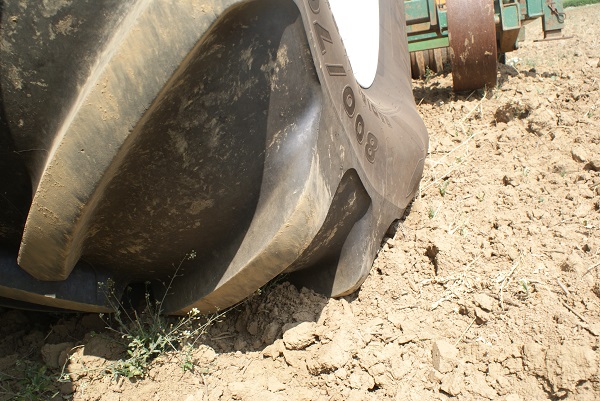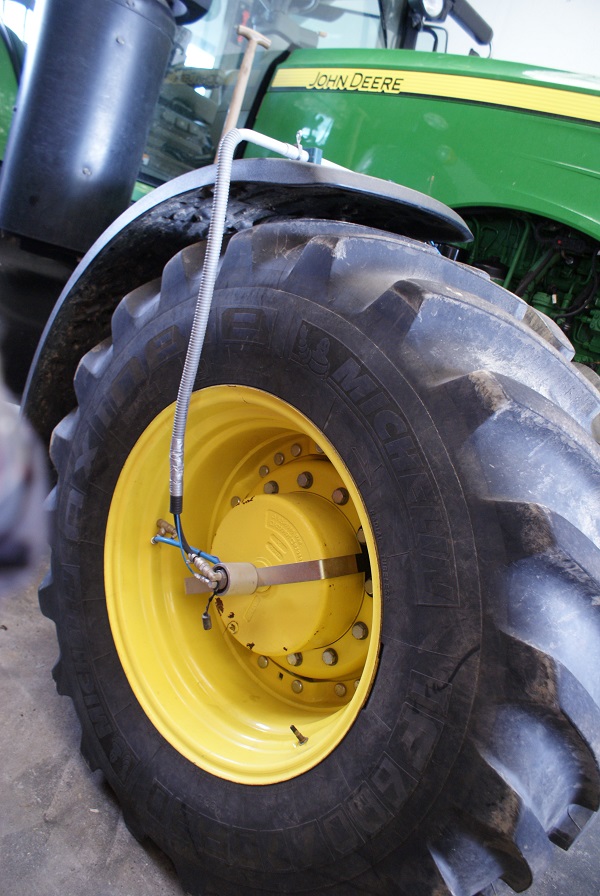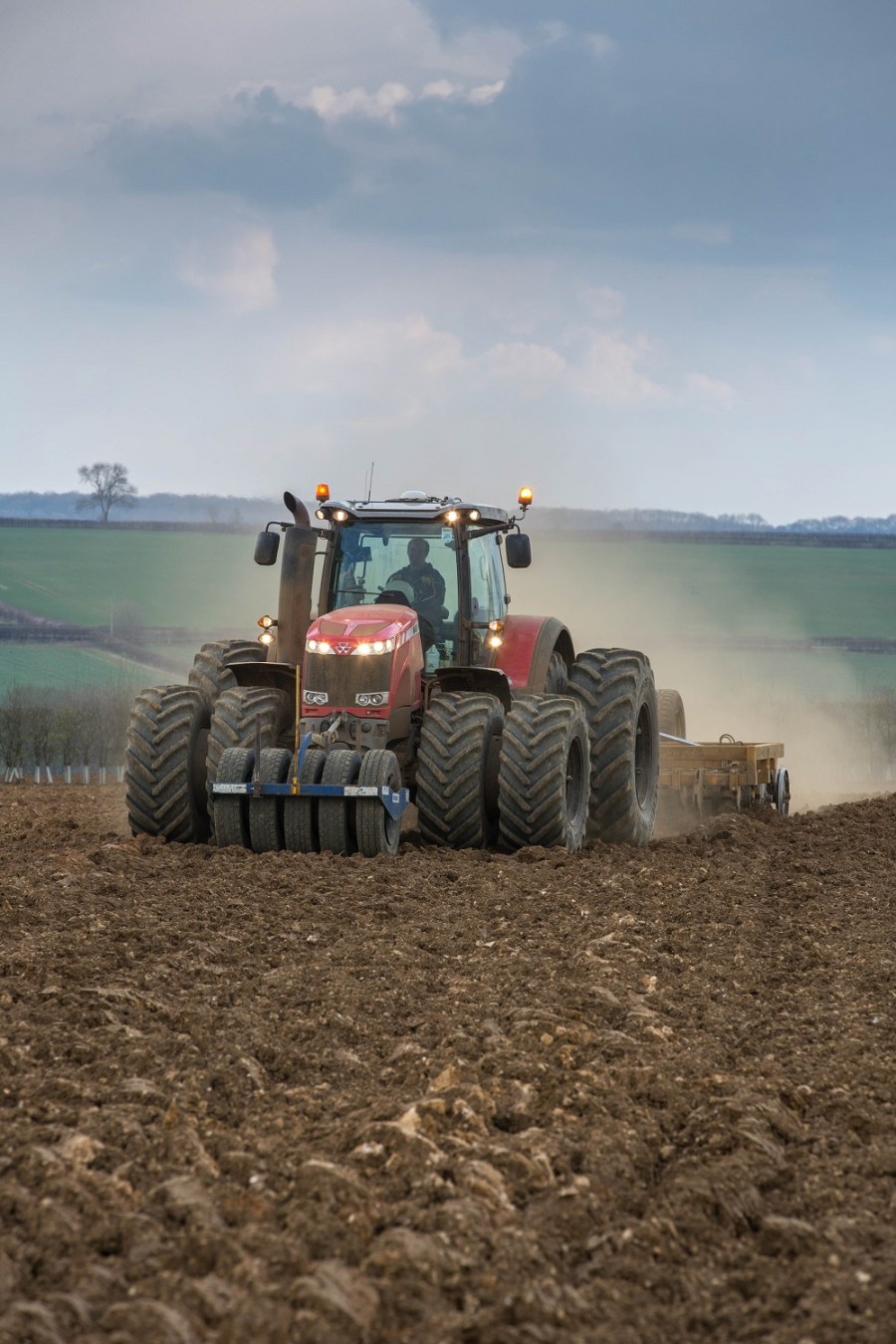Tailoring tyres to the road or the field is the quandary that face many with a busy spring workload. CPM looks at how developments in tyre technology are helping.
This is game-changing tyre technology, but it’s yet to prove itself to everybody.
By Jane Brooks
Before the season’s work gets going in earnest, there’s a double win for those who check they’re running the correct tyres at the right pressure, reckons Jon Moreton of Warwicks-based agricultural tyre dealer Farmer’s Tyre “Regularly checking and adjusting tyre pressures to suit different applications would be of benefit both to reduce soil compaction and extend general tyre life,” he says.
“A common reason manufactures give us for tyre failure is being ‘overloaded and under inflated’, typically caused by the combination of road speed and insufficient tyre pressure. With traditional tractor tyres, the faster you go the more air pressure you require. But these pressures are often considerably higher than those needed for most field operations. Many operators can’t adjust their pressures between road and field unless they have an on-board compressor.”

IF tyres carry 20% more weight than a standard tyre but at the same pressure, while VF tyres will carry 40% more weight at the same pressure.
When there’s a large block of land to cover or a slower process like ploughing, it may be worthwhile to lower the pressures once in the field to reduce soil compaction and improve traction, he continues. “But few operators spraying 10ha here and there will want to get out and manually adjust tyre pressures. So they risk either tyre damage on the road or soil compaction in the field.
If you could change pressure automatically, however, that would probably be a different matter, and this is where on-board tyre-inflation systems come in, he points out. “Fendt have done brilliantly with their system, but it’s not a new idea.”

After-market inflation systems, although a great idea, have externally fitted pipework that could get damaged.
Jon Moreton says he’s looked at after-market inflation systems and, although a great idea, those he’s seen have externally fitted pipework that could get damaged. “I think the idea of an after-market system would be embraced by the operator if it fitted inside the tractor wheels.
“Tyre manufactures are well aware that it’s difficult for operators to adjust tyre pressures in the field. In response to this, there have been developments over the past 10 years and we’ve also seen the launch of IF (Increase Flexion) and VF (Very high Flexion) tyres.
“This is game-changing tyre technology, but it’s yet to prove itself to everybody. Most of the major manufactures now produce IF and VF tyres and have been promoting their benefits. IF tyres carry 20% more weight than a standard tyre but at the same pressure, while VF tyres will carry 40% more weight at the same pressure.”
When it comes to implements Jon Moreton says a useful but seldom-used means of setting operational pressure is the static loaded radius (SLR) – the measurement from the centre of axle to the floor when the tyre has the correct deflection.
“All the tyre manufacturers publish the SLR measurement in their technical data. Although the weight of machine and implements are often known, without actually weighing the individual axles, the imposed axle weights can be difficult to calculate,” he explains.
A mounted fertiliser spreader, for example, might weigh 2t but as it’s mounted so far behind the rear wheels of the tractor, the imposed rear axle load will be closer to 3t. Likewise the front axle weight will be reduced. By checking the SLR on the tyres, you can ensure you’re getting the most from them.
“With new tractors, the cost of premium tyres gets absorbed into the machine price. However, as tractors get pushed down the ranks, it’s more difficult to justify expensive tyre options,” adds Jon Moreton.
“When considering soil compaction, the tyre is often the only thing in contact with the ground in terms of putting weight on it. So tyres are potentially responsible for all compacted areas that carry traffic across the farm. Wet harvests over the past 10 years have forced farmers to buy wider tyres for trailers and combines, and they’ve experienced the benefits first hand.
“But there are limits to how much a farm business wants to spend on tyres and in the past 12 months, with low commodity prices affecting farm incomes, the high cost of changing tyres to help reduce soil compaction isn’t easily borne by some farmers. They may have reached the limit on what they’re prepared to spend on tyres, and this could affect tyre technology and future research.”
Variogrip experience
Fendts’ Variogrip tyre pressure regulation system has been around for a year or two now. This has an airline that runs neatly through the axle, meaning there’s no need for external pipework and pressures can be adjusted on the in-cab Varioterminal from as low as 0.6bar up to 2.5bar.
But what’s it like on the ground? Matthew Fielden farm manager at Compton Estates near to Chipping Norton, Oxon, has first-hand experience of Variogrip having specified it on a Fendt 939 tractor 18 months ago.
“I’m very pleased with it and found it to be really worthwhile. It works extremely well and inflation or deflation of the tyres only takes a short time. Also, unlike some retro-fit systems that are on the market, because this is a factory-fitted option, it’s contained within the body of the tractor so there are no air lines to snag on anything.”
The Fendt is still fitted with its original Michelin IF650/65R34 and IF710/75R42 AxioBib tyres. The tractor is used for drilling, cultivating and some trailer work. According to Fendt, the patented system provides 15% more traction from the same horsepower, they say adjusting the tyre pressures provides higher traction, lower rolling resistance and lower fuel consumption. VarioGrip is controlled using Variotronic, which allows two pressures to be set and stored per axle.
Mathew Felden is impressed with the system’s performance. “It’s the main draught tractor and during the early part of the harvest pulls a 20t grain trailer. So it literally comes off a cultivator, you press a button and the tyres go to the preset pressure for pulling a heavy trailer. Our farms are ten miles apart, so in-cab tyre pressure control between field and road is a tremendous asset to us.
“The difference is noticeable if you go into the field, put the cultivator on and it’s hard going. You think I haven’t adjusted the tyre pressure, so let it down and it suddenly pulls along – it makes a massive difference and is a real plus.”
He thinks the system should be available on every tractor over 250hp. “The ability to lower tyre pressure from the tractor seat makes it easier to ensure you’re working more efficiently. Particularly when combined with the right tyres, lower tyre pressures can reduce rut depth and help avoid soil compaction.”
One problem with the system is that it takes a good few minutes for the tyres to inflate. However, to help cut filling times, Mitas has come up with a system called Aircell that apparently gives a tenfold reduction in inflation times.
This is basically a tough air pocket mounted next to the rim, taking up about 30% of the volume of the tyre, that can be pumped up to pressures as high as 8bar, while the rest of the tyre remains at low pressure.
Then, when the tyre needs to be inflated, this vessel releases the high-pressure air into the rest of the tyre, boosting pressure by up to 1bar (from 0.8bar to 1.8 bar, for example) in less than 30 secs.
Maintaining traction performance whie running the lower pressures needed to protect soil structure isn’t a simple task, says Kirk Walker of Mitas.
“Climate change could mean that the window for fieldwork at critical times becomes smaller, so growers will need to achieve greater work rates in shorter windows,” he argues.
“This inevitably means bigger equipment in the future. More horsepower also means less passes, but footprints need managing to look after soil structure. There’s already a lot growers can do to help this – it’s about balancing inflation pressure with slippage rates to get the best draft force without damaging the soil.”
Most growers operate at 15-25% slippage to maximise traction, he continues, but there’s room to reduce this without losing performance. “A lot of recent emphasis has been about developing tyres capable of carrying high load at high speed, but low sidewall deflection to allow lower operating pressures is now more important.
“Modern agricultural tyres have to achieve good field and road performance, but many operators place road handling and ride above soil protection. Maybe not on purpose, but not all operators will physically reduce pressures in the field to match conditions.
“In the future, we must look at ways of reducing the low end of operating pressures from the current 0.7bar down to 0.4bar without compromising sidewall integrity. Inflation pressure is linearly related to ground pressure.”
Collaborating with Claas, Mitas has already produced a sidewall structure allowing a 31% reduction in inflation pressure for the same load when compared to a standard tyre.
“The lower pressure possible with the CHO (Cyclic Harvest Operation) SVT tyre allows a 24% increase in footprint to spread the load and protect soils when running with full grain tanks and mounted cutter bars without needing to go to wider widths,” explains Kirk Walker.
“But while changes to structure, materials and tread patterns can go some way to meeting the demands of the future, a more radical approach could be needed.”
Mitas’ PneuTrac tyre is now under final testing and combines elements of rubber tracks with conventional pneumatic tyres. When running, it looks like a combination of the two.
“PneuTrac has a completely new structure with lateral stability up to 170% greater than a conventional tyre and a longer footprint up to 53% greater than a standard tyre of the same wheel size. It can be safely run down to 0.4bar.
“These features combine to give up to 48% more tractive force compared with conventional tyres, considerably reduced ground pressure and less slippage – which offers significant fuel savings too.”
Kirk Walker claims Mitas has re-engineered not just tyre structure but the way we think about them. “If we can do this we can lower the ground pressure of larger equipment so we can use it safely to reduce passes and be gentle on the soils. We can also use higher pressures to improve load-carrying capacity and accommodate higher speeds on the road.”
A new tyre to the market is the Bridgestone’s VT-Combine harvester tyre. Designed specifically for Cyclic Field Operations (CFO), with Improved Flexion (IF), VT-Combine offers 20% more load compared with conventional standard tyres (ETRTO standards).
The new tyre gives farmers additional speed during CFO – 15 km/h instead of the 10km/h for conventional tyres – according to Mark Sanders of Bridgestone Europe. “During harvest, farmers and agricultural contractors are under great pressure to get things done quickly and efficiently. Trial versions of VT- Combine have been tested on three continents for three full seasons with an overwhelmingly positive response.”
The tyre allows high payloads at lower inflation pressure and with a larger tyre footprint, in line with the strict IF CFO standard. This brings minimum soil compaction across a wide range of harvesting conditions, while offering farmers a load bonus of up to 55%, he adds.
There’s a reinforced casing construction, highly flexible sidewall and robust S-Line profile bead which contribute to the durability needed to keep performing under high and constantly changing payloads, claims Bridgestone. The tyre’s six-tread plies construction gives it good impact absorption, puncture resistance and easy repair.
Off-highway tyre manufacturer BKT offers numerous agricultural tyre options, such as the Agrimax Force radial tyre. Designed for tractors above 250hp, these provide higher load capacity at lower inflation pressures than similar-sized tyres. BKT says the Agrimax Force travels at up to 65km/h without having to change inflation pressure.
BKT’s Agrimax Spargo VF tyres are designed for row crop applications, whereas the Ridemax FL 693 M suits agricultural trailers. BKT says the reduced rolling resistance and class D/E speed index make the FL 693 M an ideal tyre for 75% road usage as well as off-road applications.
App-plied pressure
Mitas have introduced a new mobile tyre pressure app for Android, iOS and Windows phones. Farmers just select the tyre size they’re using, the set-up, speed and cargo weight, and the app calculates the right tyre pressure, which is displayed on the mobile phone screen.
The Mitas application can be downloaded at https://www.mitas-info.com/ Full text search by parameters is also an option.




